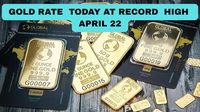Gold prices in India have reached historic heights as they crossed the Rs 1 lakh mark for 10 grams on April 22, 2025, marking a significant milestone in the bullion market. This surge is largely attributed to global uncertainties, including trade tensions between the U.S. and China, and a weakening U.S. dollar, which have driven investors towards the yellow metal as a safe haven asset.
On the Multi Commodity Exchange (MCX), gold June futures hit a record high of Rs 99,178 per 10 grams, reflecting a rise of approximately Rs 1,900 from the previous session. This increase follows a previous trading session where gold was already priced at Rs 97,200 per 10 grams before the addition of a 3% Goods and Services Tax (GST). Including GST, retail prices exceeded the Rs 1 lakh threshold, with 24-carat gold reaching Rs 1,01,350 per 100 grams.
According to market analysts, the price fluctuations in gold and silver are expected to remain volatile amid ongoing global market uncertainties. The dollar index fell to a three-year low, trading at 98.12, down by 0.16%, which has further enhanced gold's appeal. Manoj Kumar Jain from Prithvifinmart Commodity Research noted, "Uncertainty in the global financial markets and escalating US-China trade war continue to support prices of precious metals."
The physical market in India also saw significant price increases. In Delhi, the rates for standard gold (22 carat) stand at Rs 57,184 per 8 grams, while pure gold (24 carat) is priced at Rs 60,984 per 8 grams. In Mumbai, these prices are slightly higher, with standard gold at Rs 57,496 and pure gold at Rs 61,264. Chennai and Hyderabad showed similar trends, with gold prices consistently climbing across major cities.
Silver also saw a rise, with May futures contracts opening higher by 0.33% or Rs 315, priced at Rs 95,562 per kilogram. In the previous trading session, silver futures settled at Rs 95,247 per kilogram, reflecting a 0.22% gain.
The recent spike in gold prices can be linked to various factors, including President Donald Trump's criticisms of Federal Reserve Chair Jerome Powell, which have created a climate of uncertainty in the financial markets. Trump's call for interest rate cuts contrasts with Powell's stance to maintain rates until more clarity emerges regarding the economic impact of tariffs. This discord has led many investors to seek refuge in gold, as it is traditionally viewed as a stable investment during turbulent times.
Moreover, the gold market has been buoyed by significant purchases from global central banks. In 2024 alone, central banks acquired 1,037 tonnes of gold, marking one of the highest accumulations ever recorded. This trend reflects a strategic shift away from reliance on the U.S. dollar due to inflation concerns and geopolitical risks. Countries like Russia and China have notably increased their gold reserves, with Russia's holdings rising from 1,035 to 2,333 tonnes and China's from 1,054 to 2,235 tonnes between 2013 and 2023.
As gold prices continue to soar, analysts suggest that the momentum will likely persist. Goldman Sachs recently revised its gold price target from $3,300 per ounce to $3,700, with high-risk scenarios predicting prices could touch $4,500 per ounce. This optimistic outlook is supported by ongoing trade tensions and inflationary pressures, which are expected to keep gold in demand.
Experts caution, however, that while the current rally is impressive, it is essential to remain vigilant. Dr. Renisha Chainani, Head of Research at Augmont, stated, "The next potential milestone for gold could be around $3,500 if this rally continues further, but positioning may appear crowded in the short run." This indicates that while gold may remain a favorable investment, potential profit-taking could lead to price corrections.
Furthermore, the historical performance of gold during economic downturns adds to its allure. Over the last 25 years, gold has consistently performed well when equity markets face stress. For instance, during the 2008 financial crisis, gold rose by 39% while the S&P 500 dropped 57%. Similarly, during the COVID-19 pandemic in 2020, gold increased by 32% as stock markets plunged.
With the S&P 500 currently correcting almost 20% from recent highs, gold has already risen over 25% during the same period. This correlation between gold and market stress highlights its role as a safe haven during uncertain times.
Looking ahead, the outlook for gold remains constructive. Analysts recommend a ‘buy on dips’ strategy, suggesting that any declines in gold prices should be viewed as opportunities for investment. As central banks continue to bolster their reserves and geopolitical tensions persist, gold is expected to maintain its status as a favored asset.
In summary, the gold price surge to over Rs 1 lakh per 10 grams is not just a local phenomenon but part of a global trend influenced by various economic factors, including currency fluctuations, trade tensions, and central bank strategies. As investors navigate this complex landscape, gold remains a key player in the financial markets, reflecting both uncertainty and opportunity.








